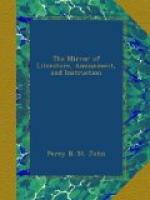[1] Hen-pecked, to be governed by a wife, (see Johnson.)
* * * * *
ANCIENT PLACES OF SANCTUARY IN LONDON AND WESTMINSTER.
“No place indeed should murder sanctuarise.” SHAKSPEARE.
The principal sanctuaries were those in the neighbourhood of Fleet-street, Salisbury-court, White Friars, Ram-alley, and Mitre-court; Fulwood’s-rents, in Holborn, Baldwin’s-gardens, in Gray’s-inn-lane; the Savoy, in the Strand; Montague-close, Deadman’s-place, the Clink, the Mint, and Westminster. The sanctuary in the latter place was a structure of immense strength. Dr. Stutely, who wrote about the year 1724, saw it standing, and says that it was with very great difficulty that it was demolished. The church belonging to it was in the shape of a cross, and double, one being built over the other. It is supposed to have been built by Edward the Confessor. Within this sanctuary was born Edward V., and here his unhappy mother took refuge with her son, the young Duke of York, to secure him from the villanous proceedings of his cruel uncle, the Duke of Gloucester, who had possession of his elder brother. The metropolis at one time (says the Rev. Joseph Nightingale,) abounded with these haunts of villany and wretchedness. They were originally instituted for the most humane and pious purposes; and owe their origin to one of the sacred institutions of the Mosaic law, which appointed certain cities of refuge for persons who had accidentally slain any of their fellow creatures. The institution, as Marmonides justly observes, was a merciful provision both for the manslayer, that he might be preserved, and for the avenger, that his blood might be cooled by the removal of the manslayer out of his sight. In the year 1487, during the Pontificate of Innocent VIII. a bull was issued, and sent here, to lay a little restraint on the privileges of sanctuary. It stated, that if thieves, murderers, or robbers, registered as sanctuary-men, should sally out and commit fresh nuisances, which they frequently did, and enter again, in such cases they might be taken out of their sanctuaries by the king’s officers. That as for debtors, who had taken sanctuary to defraud their creditors, their persons only should be protected; but their goods out of sanctuary, should be liable to seizure. As for traitors, the king was allowed to appoint them keepers in their sanctuaries, to prevent their escape. After the Reformation had gained strength, these places of sanctuary began to sink into contempt, and in the year 1697, it became absolutely necessary to take some legislative measures for their destruction.
P.T.W.
* * * * *
TRUE PHILOSOPHY.
A footman who had been found guilty of murdering his fellow-servant, was engaged in writing his confession: “I murd—” he stopped, and asked, “How do you spell murdered?”




